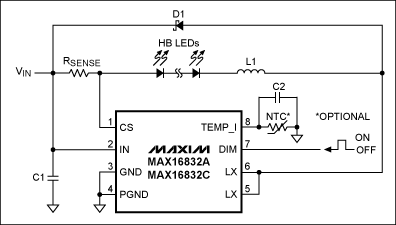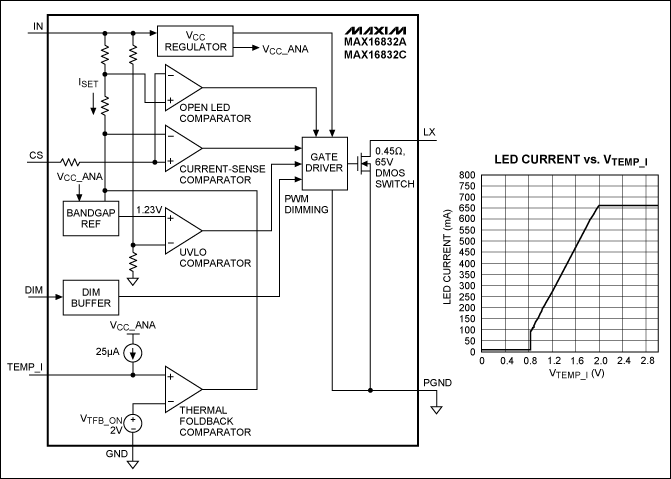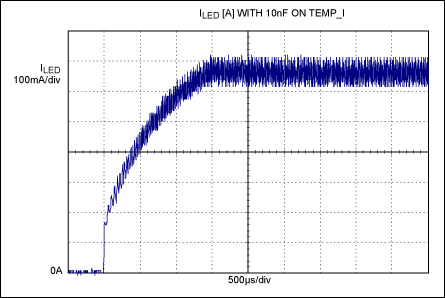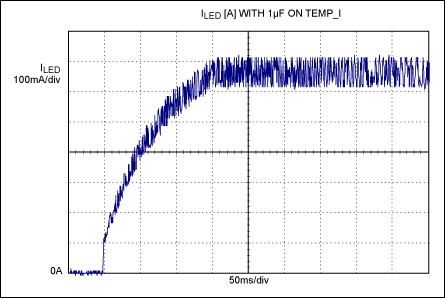

Soft-start enhances LED driver
音频电路
155人已加入
描述
To emulate the natural soft start of an incandescent bulb, this circuit makes use of the thermal-foldback protection built into an LED-driver IC (MAX16832). It thereby avoids the annoying and almost instantaneous startup otherwise exhibited by LEDs.
One of the less obvious differences between incandescent light bulbs and LED-based lights is the speed at which they start up. An incandescent bulb requires some time to reach full brightness after you switch it on, and that delay gives the eye a comfortable interval for adjusting to the bright light. LED-based lights lack this property. Instead, their brightness goes from zero to 100% almost instantly. That property is welcome in a camera flash, but rather annoying for general lighting.
Fortunately, you can use the thermal-foldback protection built into an LED-driver IC (MAX16832) to emulate the natural soft start of an incandescent bulb. Figure 1 shows the typical application circuit for this IC.

Figure 1. This application circuit is typical for the MAX16832.
A negative-temperature-coefficient resistor (NTC) connected to pin 8 implements the thermal-foldback protection, by reducing output current when the temperature of the LED string exceeds a specified temperature. A constant-current source drives 25µA through this resistor, which is thermally attached to the LEDs. When the resulting NTC voltage drops below 2V (for which RNTC < 80kΩ), an internal comparator alters (lowers) the bandgap reference voltage used by the driver for regulating the LED current. See the LED driver block diagram (Figure 2). The graph on the right in Figure 2 shows this action for a programmed LED current of 666mA. (The RSENSE value is 300mΩ.)

Figure 2. A simplified diagram (left) shows internal operation of the IC in Figure 1. The graph of LED output current versus VTEMP_I (right) assumes RSENSE = 300mΩ.
At start-up, 25µA flows into C2, which charges until its voltage reaches 25µA × RNTC. For an NTC value of 100kΩ and a capacitor value of 10nF, it should reach 2V in less than 2ms. That is, the LED current should ramp from 0mA to 666mA during those two milliseconds. Measurements confirm this assumption: a graph of LED current vs. time (Figure 3) shows that the driver settles to the maximum output current within 2ms.

Figure 3. In Figure 1, a graph of LED current vs. startup time with C2 = 10nF shows a soft-start interval of less than two milliseconds.
If you increase the capacitor value by a factor of 100 (to 1µF), the LEDs take about 200ms to reach full power (Figure 4). This timing is visible to the human eye, and gives a welcome sense that the LEDs need to "warm up."

Figure 4. In Figure 1, a graph of LED current vs. startup time with C2 = 1µF shows a soft-start interval of ~200ms.
Using the thermal-foldback circuitry to implement a soft-start for LEDs does not interfere with its protection function. The big capacitor slows that function, but its operation remains satisfactory because thermal effects are inherently slow. Nor is the PWM dimming feature affected. Only the reference voltage is influenced; the rest of the driver behaves normally.
打开APP阅读更多精彩内容
One of the less obvious differences between incandescent light bulbs and LED-based lights is the speed at which they start up. An incandescent bulb requires some time to reach full brightness after you switch it on, and that delay gives the eye a comfortable interval for adjusting to the bright light. LED-based lights lack this property. Instead, their brightness goes from zero to 100% almost instantly. That property is welcome in a camera flash, but rather annoying for general lighting.
Fortunately, you can use the thermal-foldback protection built into an LED-driver IC (MAX16832) to emulate the natural soft start of an incandescent bulb. Figure 1 shows the typical application circuit for this IC.

Figure 1. This application circuit is typical for the MAX16832.
A negative-temperature-coefficient resistor (NTC) connected to pin 8 implements the thermal-foldback protection, by reducing output current when the temperature of the LED string exceeds a specified temperature. A constant-current source drives 25µA through this resistor, which is thermally attached to the LEDs. When the resulting NTC voltage drops below 2V (for which RNTC < 80kΩ), an internal comparator alters (lowers) the bandgap reference voltage used by the driver for regulating the LED current. See the LED driver block diagram (Figure 2). The graph on the right in Figure 2 shows this action for a programmed LED current of 666mA. (The RSENSE value is 300mΩ.)

Figure 2. A simplified diagram (left) shows internal operation of the IC in Figure 1. The graph of LED output current versus VTEMP_I (right) assumes RSENSE = 300mΩ.
At start-up, 25µA flows into C2, which charges until its voltage reaches 25µA × RNTC. For an NTC value of 100kΩ and a capacitor value of 10nF, it should reach 2V in less than 2ms. That is, the LED current should ramp from 0mA to 666mA during those two milliseconds. Measurements confirm this assumption: a graph of LED current vs. time (Figure 3) shows that the driver settles to the maximum output current within 2ms.

Figure 3. In Figure 1, a graph of LED current vs. startup time with C2 = 10nF shows a soft-start interval of less than two milliseconds.
If you increase the capacitor value by a factor of 100 (to 1µF), the LEDs take about 200ms to reach full power (Figure 4). This timing is visible to the human eye, and gives a welcome sense that the LEDs need to "warm up."

Figure 4. In Figure 1, a graph of LED current vs. startup time with C2 = 1µF shows a soft-start interval of ~200ms.
Using the thermal-foldback circuitry to implement a soft-start for LEDs does not interfere with its protection function. The big capacitor slows that function, but its operation remains satisfactory because thermal effects are inherently slow. Nor is the PWM dimming feature affected. Only the reference voltage is influenced; the rest of the driver behaves normally.
声明:本文内容及配图由入驻作者撰写或者入驻合作网站授权转载。文章观点仅代表作者本人,不代表电子发烧友网立场。文章及其配图仅供工程师学习之用,如有内容侵权或者其他违规问题,请联系本站处理。
举报投诉
-
XL6001 including output LED open faults2019-08-13 987
-
SL8830 启动电压2.5V LED面板灯升压恒流芯片LED车灯照明 LED开路保护 过温保护2021-08-17 1301
-
CAT3224 Flash LED Driver Evalu2009-01-19 831
-
High Power LED Driver IC2009-09-07 546
-
LED可控硅调光驱动方案 LED Driver2010-03-28 1432
-
Extending Soft-Start2009-05-04 1798
-
SEPIC Backlight LED Driver,SEP2009-07-18 1768
-
Boost Backlight LED Driver,背光L2009-07-29 2345
-
Boost driver for long LED stri2010-05-01 1038
-
Protect LED driver in backlit displays2011-02-02 1727
-
基于LED/OLED Driver通用发光二极管驱动器的参考设计2021-06-29 513
全部0条评论

快来发表一下你的评论吧 !

